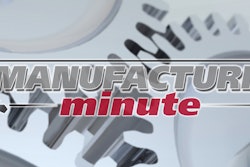Technological developments in IoT and smart machines are promising to give businesses in the process manufacturing industry a better view of all processes and steps in the supply chain. This is especially important for companies in the food & beverage industry, where traceability and health & safety are top priorities. But are these technologies mature enough for businesses to adopt in 2016?
Jakob Björklund, Industry Director for Process Manufacturing at IFS, take a look at the top trends he predicts will drive big changes in the process manufacturing industry in 2016.
The Internet of Things will help improve traceability
The Internet of Things is still relatively new to process manufacturing so things aren’t going to happen overnight. 2016 will be another year for businesses in the process industry to watch and learn. There are companies out there that are leading the charge, particularly in the pharmaceutical industry which needs to prepare for the EU Falsified Medicines Directive that is expected to go live in 2018. The technologies that will enable pharma companies to meet this directive are crucial, particularly around traceability, and 2016 will be the year that they study and acquire these technologies to ensure that they can be rolled out across the global supply chain in time.
The collection of data via sensors and scales is not new to the process industry – in fact, companies that run asset-intensive processes at really large-scale have been doing it for decades. But, historically, this ability to collect data has come with a big price tag. The Internet of Things heralds a new age for an increased level of traceability, one that is no longer the realm of larger companies but opens the door for smaller businesses. Now everything has some sort of sensor and can be traced, from forklift trucks to storage locations, pallets to trucks. Roughly 25% of our customers are collecting transactional data today. I predict that this number will increase to around 80% in the next five years because of the increase in availability of this technology and a decreased entry cost.
Smart machines are making decisions for you
Smart machines, or robots as they’re more commonly known, are increasingly working their way into the process industry, expected to perform many routine tasks in manufacturing and warehousing. Gartner predicts that by 2018, 50% of the fastest growing companies will have fewer employees than smart machines. I’m not just talking about the machines that you see building cars in adverts. I’m talking about smart machines that are highly autonomous and able to make their own decisions. For example, a robot that picks customer orders will decide on the most efficient route and make product allocation priorities in the case of a shortage.
The future of process manufacturing, today
Today, these decisions are carried out by humans, often on the basis of a recommendation from the WMS or ERP system. Companies are already starting to experiment and we will see wider adoption of smart machines in 2016. This adoption will also lead to changes in ERP solutions as well – interfaces will change, they will need to deal with more transactional data and above all, they will provide information necessary to make decisions rather than making the decisions within the ERP. With widespread adoption continuing to grow, 2016 will be a year where process manufacturers increase their investment in smart machines to achieve efficiencies. However, the complexity of supply chains and manufacturing processes mean that widespread adoption across the value chain will take longer than 12 months.
Scan and see – Traceability and customer demand
I have a particular interest in the rise of adoption in public cloud services as a platform to manage the data produced by traceability. By this I mean providing consumers with the ability to scan the barcode on their sirloin steak at the supermarket and track its journey from the farm to the supermarket shelf. This is only possible through traceability in the supply chain – from the manufacturer who will register the goods which are then picked up by the transport company that can log weight, miles driven and even the temperature of the vehicle, to the shop that registers arrival and logs into its system and so on.
This level of traceability is becoming increasingly important for food manufacturers for who brand reliability is absolutely crucial. Ever since the well-known horse meat scandal that impacted the food industry a few years ago, these companies will do everything to ensure that the product they sell is absolutely perfect. Widespread roll out of this level of traceability is still a little way off but not by a million miles so companies will need to spend 2016 putting a strategy in place for the deployment of this technology.























